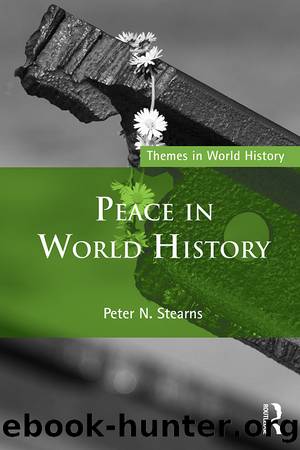Peace in World History by Peter N. Stearns

Author:Peter N. Stearns
Language: eng
Format: epub
Publisher: Routledge
Pacifist groups
The decades after 1814–15 truly constituted the birthplace for an amazing variety of pacifist or peace-seeking organizations: nothing like this had ever occurred before. The focus was almost entirely Western (though including Russia), which was a clear limitation. But many participants were convinced that their enthusiasm, and the justice of their cause, would carry the day in any event.
Peace organizations formed part of a larger flowering of reform groups of various types – ultimately embracing temperance movements, prison and asylum reform, anti-slavery, women’s rights, and the protection of labor. Various efforts interconnected, which could both strengthen the peace movement by associating it with other causes, and distract by multiplying goals. Lots of people now believed that the world could and should be made better, and fast; the peace organizations were a key part of this process.
Probably the first such group emerged in the United States in 1814, in the Massachusetts Peace Society, which in 1828 expanded to become the American Peace Society. The group issued a regular periodical, called the Advocate of Peace, beginning in 1834, and sent speakers around the country in an age when the lecture was an extraordinarily popular medium. Quaker involvement was strong. The movement sponsored national meetings and participated in international gatherings, ultimately moving its headquarters from Boston to Washington in obvious hopes of influence national policy. Under the leadership of William Ladd, from 1828 onward, a strong focus on new mechanisms for dispute mediation emerged: Ladd urged that “unless some means of terminating disputes by amicable and rational methods are devised,” retaliation, revenge and war would be the inevitable consequence. A “spirit of peace” was important, but more specific mediation procedures were essential, and Ladd sketched the need for an international organization to agree on laws to preserve peace, though he envisaged only Christian and “civilized” nations. More broadly, American organizations, and individual pacifists like Henry Thoreau, were active in criticizing particular national war efforts, such as the Mexican American War, though most ended up supporting the Union cause in the Civil War as a policy action justified against slavery.
In Britain the Peace Society emerged in 1816, again with Quaker involvement, for the self-proclaimed purpose of promoting permanent and universal peace; it urged arbitration in disputes and a process of gradual and simultaneous disarmament of all nations. Here too there was a regular publication, the Herald of Peace, and a host of conferences and lectures.
The same pattern occurred in most European countries. France, Belgium, Switzerland and Germany all had early groups, complete with publications. By 1843 the networks among these organizations was sufficient to permit a first international congress, which enhanced the sense of global collaboration while discussing disarmament, international arbitration, and some kind of international federation of states. Soon, an International League for Peace and Liberty formed, the first of many loosely organized international coordinating bodies.
The efforts, by midcentury, involved a true Who’s Who of European intellectuals, including novelists like Victor Hugo in France. Hugo, for example, in a comment to the
Download
This site does not store any files on its server. We only index and link to content provided by other sites. Please contact the content providers to delete copyright contents if any and email us, we'll remove relevant links or contents immediately.
| Archaeology | Essays |
| Historical Geography | Historical Maps |
| Historiography | Reference |
| Study & Teaching |
Underground: A Human History of the Worlds Beneath Our Feet by Will Hunt(11264)
Navigation and Map Reading by K Andrew(4556)
Sapiens by Yuval Noah Harari(4546)
Barron's AP Biology by Goldberg M.S. Deborah T(3634)
The Sympathizer by Viet Thanh Nguyen(3505)
5 Steps to a 5 AP U.S. History, 2010-2011 Edition (5 Steps to a 5 on the Advanced Placement Examinations Series) by Armstrong Stephen(3406)
Three Women by Lisa Taddeo(2924)
The Comedians: Drunks, Thieves, Scoundrels, and the History of American Comedy by Nesteroff Kliph(2792)
Water by Ian Miller(2588)
Drugs Unlimited by Mike Power(2195)
DarkMarket by Misha Glenny(1849)
The House of Government by Slezkine Yuri(1846)
The Library Book by Susan Orlean(1738)
A Short History of Drunkenness by Forsyth Mark(1724)
Revived (Cat Patrick) by Cat Patrick(1679)
The Woman Who Smashed Codes by Jason Fagone(1650)
The House of Rothschild: Money's Prophets, 1798-1848 by Niall Ferguson(1620)
And the Band Played On by Randy Shilts(1619)
Birth by Tina Cassidy(1572)
